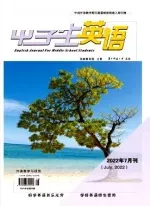反意疑问句典型错误例析
安徽省濉溪县百善中学 姜经志 供稿
1.他从未去过长城,是吗?
[误]He has never been to the Great Wall,hasn’t he?
[正]He has never been to the Great Wall,has he?
[析]当陈述部分含有never,few,little,nothing,nobody,hardly(几乎不)等表示否定意义的词时,疑问部分须用肯定式。
2.她父亲是你的老师,是吗?
[误]Her father is your teacher,isn’t her father?
[正]Her father is your teacher,isn’t he?
[析]附加问句中的主语要用代词,如果陈述句的主语是代词,用相应的代词即可,如果陈述句的主语是名词,用相应的代词指代该名词。
3.这台机器有毛病,是吗?
[误]Something is wrong with the machine,isn’t there?
[正]Something is wrong with the machine,isn’t it?
[析]当陈述部分的主语是something,everything,nothing等时,疑问部分的主语用it。
4.汤姆能单独完成这项工作,是吗?[误]Tom can finish the work alone,doesn’t he?
[正]Tom can finish the work alone,can’t he?
[析]如果陈述句中有系动词或情态动词或助动词,附加疑问句中用与它相应的肯定或否定形式即可;如果没有,就要根据陈述句的时态选择适当的助动词。该句有情态动词can,所以附加疑问句中用can’t。
5.今天大家都到了,是吗?
[误]Everyone is here today,isn’t it?
[正]Everyone is here today,aren’t they?
[析]陈述部分的主语是someone,somebody,everyone,everybody时,疑问部分的主语常用they。
6.瓶里有些水,是吗?
[误]There is some water in the bottle,isn’t it?
[正]There is some water in the bottle,isn’t there?
[析]当陈述部分是“There be”结构时,疑问部分用there作主语。
7.打开窗户,好吗?
[误]Open the window,don’t you?
[正]Open the window,will you?
[析]当陈述部分是祈使句时,疑问部分常will you。
8.我不认为她是对的,不是吗?
[误]I don’t think she is right,do I?
[正]I don’t think she is right,is she?
[析]当陈述部分的主句是“I(don’t)think(believe/suppose)……”后接宾语从句时,疑问部分的主语代词和动词必须和从句保持一致。
9.我迟到了,是吗?
迟恒将“拟发”的陵矿尾砂危库治理工程的采访调查报道发给陵矿办事处,标题是“不筑铜堤铁坝,难保万世巍然”,对方表示,需认真核实后回复。
[误]I’m late,am not I?
[正]I’m late,aren’t I?
[析]当陈述部分以“I’m…”开头时,疑问部分常用“aren’t you?”或“am I not?”。
10.多么漂亮的花啊,不是吗?
[误]What beautiful flowers,don’t they?
[正]What beautiful flowers,aren’t they?
[析]当陈述部分是感叹句时,其疑问部分要用否定式,一般用动词“to be”的一般现在时否定式,主语视具体情况而定。
[误]We have to get there on time,haven’t we?
[正]We have to get there on time,don’t we?
[析]当陈述部分的谓语动词含有“have to/has to/had to”时,疑问部分常用助动词do的适当形式。
12.她看上去不高兴,是吗?
[误]She looks unhappy,does she?
[正]She looks unhappy,doesn’t she?
[析]当陈述部分的否定词是由加否定前缀或后缀构成的,则仍视陈述部分为肯定式,疑问部分用否定式。

